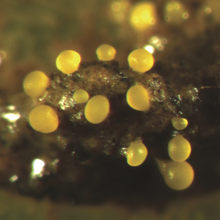
Back جرثومة مخاطية Arabic جرثومه مخاطيه ARZ Mixobacteris Catalan Myxobakterie Czech Myxobacteria German Myxococcales Spanish میکسوباکتریا Persian Myxococcales French Mixobacterias Galician Միքսոբակտերիաներ Armenian
| Myxobacteria | |
|---|---|

| |
| Myxococcus xanthus | |
| Scientific classification | |
| Domain: | Bacteria |
| Phylum: | Myxococcota |
| Class: | Myxococcia Waite et al. 2020[1] |
| Order: | Myxococcales Tchan et al. 1948 |
| Families & genera | |
| Synonyms | |
|
"Myxococcidae" Cavalier-Smith 2020 | |
The myxobacteria ("slime bacteria") are a group of bacteria that predominantly live in the soil and feed on insoluble organic substances. The myxobacteria have very large genomes relative to other bacteria, e.g. 9–10 million nucleotides except for Anaeromyxobacter[2] and Vulgatibacter.[3] One species of myxobacteria, Minicystis rosea,[4] has the largest known bacterial genome with over 16 million nucleotides. The second largest is another myxobacteria Sorangium cellulosum.[5][6]
Myxobacteria can move by gliding.[7] They typically travel in swarms (also known as wolf packs), containing many cells kept together by intercellular molecular signals. Individuals benefit from aggregation as it allows accumulation of the extracellular enzymes that are used to digest food; this in turn increases feeding efficiency. Myxobacteria produce a number of biomedically and industrially useful chemicals, such as antibiotics, and export those chemicals outside the cell.[8]
Myxobacteria are used to study the polysaccharide production in gram-negative bacteria like the model Myxococcus xanthus which have four different mechanisms[9] of polysaccharide secretion and where a new Wzx/Wzy mechanism producing a new polysaccharide was identified in 2020.[9]
Myxobacteria are also good models to study the multicellularity in the bacterial world.[10]
- ^ Waite DW, Chuvochina M, Pelikan C, Parks DH, Yilmaz P, Wagner M, Loy A, Naganuma T, Nakai R, Whitman WB, Hahn MW, Kuever J, Hugenholtz P. (2020). "Proposal to reclassify the proteobacterial classes Deltaproteobacteria and Oligoflexia, and the phylum Thermodesulfobacteria into four phyla reflecting major functional capabilities". Int J Syst Evol Microbiol. 70 (11): 5972–6016. doi:10.1099/ijsem.0.004213. PMID 33151140.
- ^ Thomas SH, Wagner RD, Arakaki AK, Skolnick J, Kirby JR, Shimkets LJ, Sanford RA, Löffler FE (May 2008). "The mosaic genome of Anaeromyxobacter dehalogenans strain 2CP-C suggests an aerobic common ancestor to the delta-proteobacteria". PLOS ONE. 3 (5): e2103. Bibcode:2008PLoSO...3.2103T. doi:10.1371/journal.pone.0002103. PMC 2330069. PMID 18461135.
- ^ "Vulgatibacter incomptus strain DSM 27710, complete genome". 2015-08-19.
{{cite journal}}: Cite journal requires|journal=(help) - ^ Shilpee Pal, Gaurav Sharma & Srikrishna Subramanian (2021-09-13). "Complete genome sequence and identification of polyunsaturated fatty acid biosynthesis genes of the myxobacterium Minicystis rosea DSM 24000T". BMC Genomics. 22 (1): 655. doi:10.1186/s12864-021-07955-x. PMC 8436480. PMID 34511070.
- ^ Schneiker S, Perlova O, Kaiser O, Gerth K, Alici A, Altmeyer MO, et al. (November 2007). "Complete genome sequence of the myxobacterium, Sorangium cellulosum". Nat. Biotechnol. 25 (11): 1281–9. doi:10.1038/nbt1354. PMID 17965706.
- ^ Land M, Hauser L, Jun SR, Nookaew I, Leuze MR, Ahn TH, Karpinets T, Lund O, Kora G, Wassenaar T, Poudel S, Ussery DW (March 2015). "Insights from 20 years of bacterial genome sequencing". Funct. Integr. Genomics. 15 (2): 141–61. doi:10.1007/s10142-015-0433-4. PMC 4361730. PMID 25722247.
- ^ Mauriello EM, Mignot T, Yang Z, Zusman DR (June 2010). "Gliding motility revisited: how do the myxobacteria move without flagella?". Microbiol. Mol. Biol. Rev. 74 (2): 229–49. doi:10.1128/MMBR.00043-09. PMC 2884410. PMID 20508248.
- ^ Reichenbach H (September 2001). "Myxobacteria, producers of novel bioactive substances". J. Ind. Microbiol. Biotechnol. 27 (3): 149–56. doi:10.1038/sj.jim.7000025. PMID 11780785. S2CID 34964313.
- ^ a b Islam ST, Vergara Alvarez I, Saïdi F, Guiseppi A, Vinogradov E, Sharma G, et al. (June 2020). "Modulation of bacterial multicellularity via spatio-specific polysaccharide secretion". PLOS Biology. 18 (6): e3000728. doi:10.1371/journal.pbio.3000728. PMC 7310880. PMID 32516311.
- ^ Islam ST, Vergara Alvarez I, Saïdi F, Guiseppi A, Vinogradov E, Sharma G, et al. (June 2020). "Modulation of bacterial multicellularity via spatio-specific polysaccharide secretion". PLOS Biology. 18 (6): e3000728. doi:10.1371/journal.pbio.3000728. PMC 7310880. PMID 32516311.
© MMXXIII Rich X Search. We shall prevail. All rights reserved. Rich X Search